Our editors independently select these products. Making a purchase through our links may earn Well+Good a commission
The 14 Best Moisturizers for Rosacea, According to Dermatologists
Learn the best dermatologist-recommended formulas for rosacea-prone skin, plus the soothing ingredients to look out for.

According to the American Academy of Dermatology, an estimated 14 million people deal with rosacea. Despite its prevalence, though, rosacea is still a tough skin condition to pin down—and it’s even trickier to treat. “Rosacea is specifically defined by persistent redness of the central portion of the face,” says Rachel Westbay, MD, a board-certified dermatologist at Marmur Medical.
Experts in This Article
medical director at the Ottawa Skin Clinic
board-certified dermatologist and founder of DERMAdoctor
board-certified dermatologist and co-founder of Fig.1
board-certified dermatologist and founder of AmberNoon
board-certified dermatologist and founder of FACET Dermatology
director of cosmetic and clinical research in dermatology and associate professor of dermatology at Mount Sinai Hospital
double board-certified dermatologist and founder of Foy
board-certified dermatologist at Schweiger Dermatology Group in New York
board-certified dermatologist at Marmur Medical
director of Proactive Dermatology Group and founder of Cortina
According to Dr. Westbay, rosacea symptoms can range from intense blushing across the cheeks and nose, acne-like bumps, and small, dilated blood vessels, to stinging, swollen skin, and excessive dryness. Having rosacea is a lot like having sensitive, redness-prone skin—but not everyone who deals with redness has rosacea. (It’s confusing, I know.) To help clear things up, we asked dermatologists to weigh in on the differences between rosacea and redness, the ingredients that help keep them in check, and the best moisturizers for rosacea that you’ll want to add to your lineup ASAP.
Best moisturizers for rosacea, at a glance:
- Best overall: Paula’s Choice Rescue & Repair Intensive Moisturizer, $33
- Best lightweight: Vanicream Daily Facial Moisturizer for Sensitive Skin, $13
- Best treatment: ZO Skin Care ZO Rozatrol, $93
- Best rich cream: Aveeno Calm + Restore Redness Relief Moisturizer, $19
- Best gel: Biossance Squalane + Probiotic Balancing Gel Moisturizer, $54
- Best azelaic acid: The Ordinary Azelaic Acid 10% Suspension Brightening Cream, $12
- Best with colloidal oatmeal: Topicals Like Butter Moisturizer, $34
- Best with SPF: Dr. Jart Cicapair Tiger Grass Color Correcting Treatment SPF 30, $52
- Best night cream: Eucerin Redness Relief Night Creme, $11
- Best value: La Roche-Posay Toleriane Double Repair Face Moisturizer, $22
- Best splurge: SkinCeuticals Redness Neutralizer, $78
- Best multipurpose: CeraVe Moisturizing Cream, $19
- Best for microbiome support: Bliss Mighty Biome Ultra-Hydrating Moisturizer Concentrate, $15
- Best oil-free: Clinique Redness Solutions Daily Relief Cream, $63
The best moisturizers for rosacea
Best overall

Best overall: Paula’s Choice Rescue & Repair Intensive Moisturizer — $33.00
Key ingredients: Sunflower seed oil, natural prebiotics, allantoin, mushroom extract
This new and improved version of Paula’s Choice soothing moisturizer contains the perfect cocktail of skin-soothing ingredients that help reduce the look of rosacea, according to Rachel Nazarian, MD, a board-certified dermatologist based in NYC. “This product takes the right approach by using topical anti-inflammatory antioxidant ingredients—like mushroom extract—to combat redness and irritation, and by using calming emollients—allantoin—which can be used safely to condition skin.” What you get is a cushioned, soft cream that instantly calms skin, deeply moisturizes, all while targeting the look of redness.
Size: 0.5 oz.
Pros:
- Ideal for dry, reactive skin
- Has hydrating formula
- Targets redness
- Formulated with sunflower seed oil
Cons:
- Some may not like the smell
Best lightweight
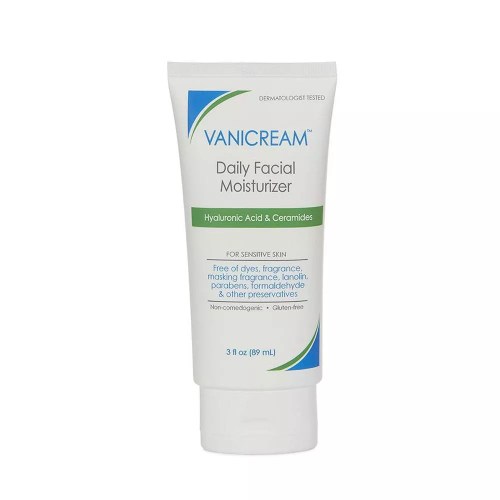
Best lightweight: Vanicream Daily Facial Moisturizer for Sensitive Skin — $14.00
Key ingredients: Ceramides, hyaluronic acid
“Vanicream’s hyaluronic acid moisturizer is an inexpensive and non-irritating choice to help moisturize the skin,” says Dr. Collins. The budget-friendly moisturizer also contains ceramides to support your skin’s moisture barrier—a must for reactive, rosacea-prone skin—all while being dye, paraben, and fragrance free. The moisturizer also comes with the recommendation of Dr. Ilyas who loves its simple and straightforward ingredients list. “It’s basic, it’s simple, [and] it does what it needs to do,” she says.
Size: 3 oz.
Pros:
- Affordable
- Formulated with hyaluronic acid and ceramides
- Fragrance-, paraben-, and formaldehyde-free
- Lightweight formula
Cons:
- May not be ideal for acne-prone skin
Best treatment
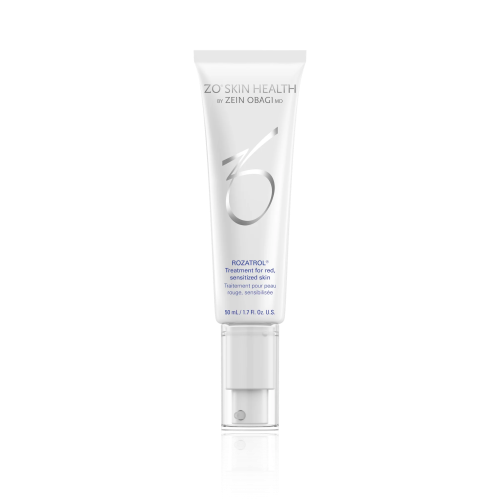
Best treatment: ZO Skin Care ZO Rozatrol — $93.00
Key ingredients: Lactose, farnesyl acetate, farnesol, panthenyl triacetate, papain, glycerin
This cream-like treatment comes recommended by Dr. Zeichner for its ultra-hydrating formula. Infused with vitamin E and amino acids, “this moisturizer helps calm the skin, offers hydration benefits, and has been clinically proven to improve facial redness,” says Dr. Zeichner. Even more, the formula is packaged in a pump bottle, making application easy peasy.
Size: 1.7 oz.
Pros:
- Contains vitamin E and amino acids
- Reduces redness
- Hydrating
Cons:
- Expensive
Best rich cream

Best rich cream: Aveeno Calm + Restore Redness Relief Moisturizer — $27.00
Key ingredients: Cermaides, vitamin B5
For rosacea-prone skin in need of rich moisture, you can’t go wrong with Aveeno’s Redness Relief Moisturizer, according to Dr. Friedler. The nourishing cream is formulated with oat kernel flour—a favorite for sensitive skin—skin-soothing feverfew (aka wild chamomile), along with ceramide and vitamin B5 to instantly reduce the look of redness, calm sensitivity, and support a healthy, moisturized skin barrier.
Size: 1.7 oz.
Pros:
- Fragrance-, paraben-, and phthalate-free
- Contains soothing oat formula
- Hypoallergenic
Cons:
- May be too thick for some
Best gel
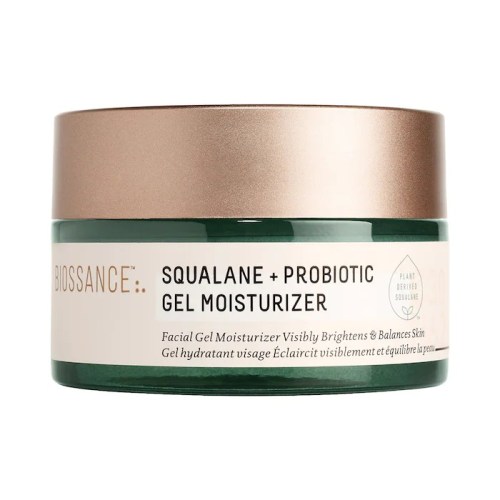
Best gel: Biossance Squalane + Probiotic Balancing Gel Moisturizer — $54.00
Key ingredients: Encapsulated probiotics, bisabolol, squalane
If a gel moisturizer is more your speed, you’re going to want to try the Biossance Squalane + Probiotic Gel Moisturizer. “[It’s a] helpful moisturizer for those with rosacea because it’s ultra-hydrating and infused with squalene and probiotics that are extra soothing for the skin,” says Dr. Maclellan. It also contains bisabolol—an ingredient derived from chamomile that’s a derm-favorite for rosacea. “Bisabolol provides soothing benefits and helps with redness and irritation,” says Alain Michon, MD, medical director at the Ottawa Skin Clinic.
Size: 1.7 oz.
Pros:
- Doesn’t clog pores
- Quells inflammation and redness
- Restores skin microbiome
Cons:
- Expensive
Best azelaic acid
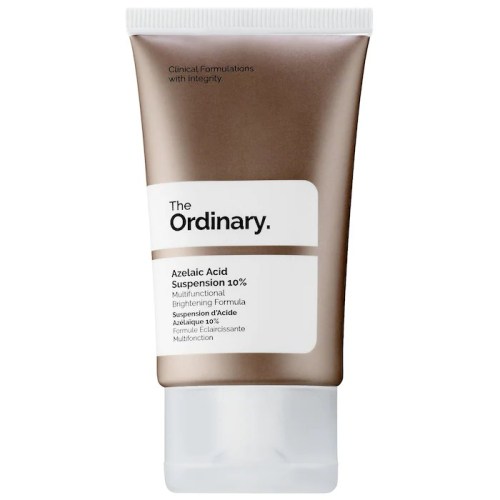
Best azelaic acid: The Ordinary Azelaic Acid 10% Suspension Brightening Cream — $13.00
Key ingredients: Azelaic acid
The Ordinary’s Azelaic Acid Brightening Cream is another affordable, dermatologist favorite. Azelaic acid is loved for its smoothing and skin-brightening benefits that help support even skin tone and texture, and most importantly, its anti-inflammatory properties that help soothe sensitivity and reduce the look of redness. And it’s the hero ingredient in this brightening cream, packing a 10 percent concentration. Use it to target rosacea-prone areas, or apply it all over the face to support a brighter, more even-toned complexion.
Size: 1 oz.
Pros:
- Brightens skin tone
- Reduces blemishes
- Ideal for normal, dry, combination, and oily skin
- Affordable
Cons:
- Some may not like the scent
Best with colloidal oatmeal

Best with colloidal oatmeal: Topicals Like Butter Moisturizer — $34.00
Key ingredients: Colloidal oatmeal, green tea, madecassoside
This moisturizer is formulated with one-percent colloidal oatmeal—another ingredient that Dr. Yadav recommends—for rosacea-prone skin. Colloidal oatmeal is known to have anti-inflammatory properties, helping soothe the skin and calm any patchness of redness. The cream formula is also enriched with green tea and madecassoside, a derivative of the plant extract Centella Asiatica, to reinforce the moisturizer’s skin-soothing properties. It is made for all skin types, including oily skin, and you can use it as a spot treatment or an all-over cream. Regardless, the moisturizer hydrates the skin instantly—and over time.
Size: 1.7 oz.
Pros:
- Creamy, hydrating formula
- Reduces redness and itch
- Formulated with colloidal oatmeal and green tea
Cons:
- Packaging may cause oozing
Best with SPF
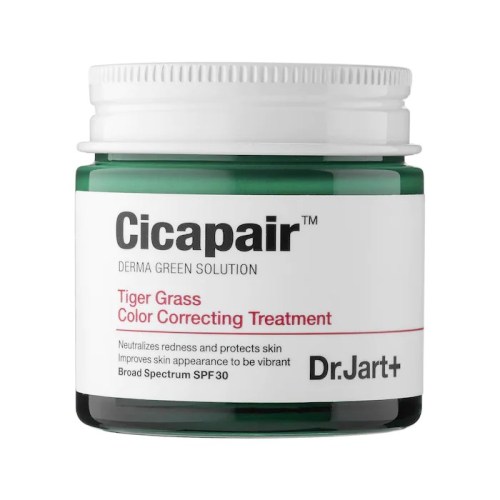
Best with SPF: Dr. Jart Cicapair Tiger Grass Color Correcting Treatment SPF 30 — $54.00
Key ingredients: Cica, zinc oxide, titanium dioxide
“I love this treatment for those with rosacea as it contains green pigments to cancel out redness, along with SPF which is so important for those with rosacea, as sun exposure can trigger flare-ups,” says Courtney Rubin, MD, MBE, FAAD, board-certified dermatologist, and chief medical officer and co-founder of Fig.1. The secret? Centella Asiatica (also known as tiger grass or cica), a K-beauty staple that soothes and moisturizes skin. Combine the calming centella with the cream’s buildable pigments and natural matte finish, and you’ve got a skin-care and makeup hybrid in one.
Size: 1.7 oz.
Pros:
- SPF 30
- Evens out skin tone
- Targets redness
Cons:
- Expensive
Best night cream
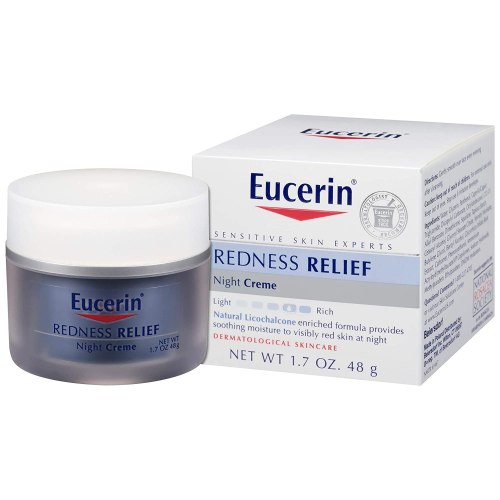
Best night cream: Eucerin Redness Relief Night Creme, $11 — $11.00
Key ingredients: Squalane, glycerin, licorice
To help combat the effects of rosacea while you snooze, Dr. Friedler recommends the Eucerin Redness Relief Night Creme. The fragrance-free moisturizer has a gel-cream texture that gently cools, calms, and moisturizes dry, sensitive skin on contact, thanks to a key ingredient called licochalcone, a natural skin-soother derived from licorice root—a favorite for its anti-inflammatory benefits. Oh, and did I mention that it has over 5,000 5-star ratings on Amazon?
Size: 1.7 oz.
Pros:
- Fragrance-and dye-free
- Reduces redness
- Enriched with licorice root extract
- Affordable
Cons:
- May feel greasy for some
Best value

Best value: La Roche-Posay Toleriane Double Repair Face Moisturizer — $22.00
Key ingredients: Ceramides, niacinamide, glycerin, La Roche Posay thermal water
La Roche-Posay’s Toleriane Double Repair Moisturizer is specially formulated with sensitive skin in mind—and both Dr. Friedler and Dr. Ilyas recommend it for rosacea-prone skin. “A lot of our rosacea-prone patients need something that actually seeps [into the skin] nicely, hydrates, and creates a protective layer [for their skin],” says Dr. Ilyas, and this moisturizer ticks all the boxes. Plus, for just over $20 bucks, you’re getting some of the best rosacea-friendly ingredients: ceramide-3 to nourish and strengthen your skin’s moisture barrier and niacinamide to soothe inflammation, boost your barrier, and help brighten the look of redness. Plus, it has over 21,000 five-star ratings on Amazon, so you know it’s worth the hype.
Size: 2.5 oz.
Pros:
- Fragrance-free
- Formulated with ceramides and niacinamide
- Ideal for all skin types
- Has lightweight, creamy texture
Cons:
- Some reviewers say the moisturizer pills
Best splurge

Best splurge: SkinCeuticals Redness Neutralizer — $79.00
Key ingredients: Palmitoyl tripeptide-8, botanical extracts
“A great option to help with rosacea is the SkinCeuticals Redness Neutralizer,” says Dr. Michon. “[It’s] ideal for helping combat environmental triggers in order to alleviate any skin blotchiness and discomfort associated with rosacea. It cools while promoting smoothness, skin radiance, and neutralizes redness effectively.”
To build on the treatment’s redness reducing benefits, Dr. Michon recommends layering the SkinCeuticals Triple Lipid Restore Cream ($150) on top, saying it’s “an effective anti-aging cream that helps rebuild the skin’s moisture barrier.” The combo will run you a pretty penny, but is sure to kick your rosacea redness to the curb.
Size: 1.7 oz.
Pros:
- Lightweight formula
- Targets redness
- Infused with botanical extracts for cooling effect
Cons:
- Expensive
Best multipurpose
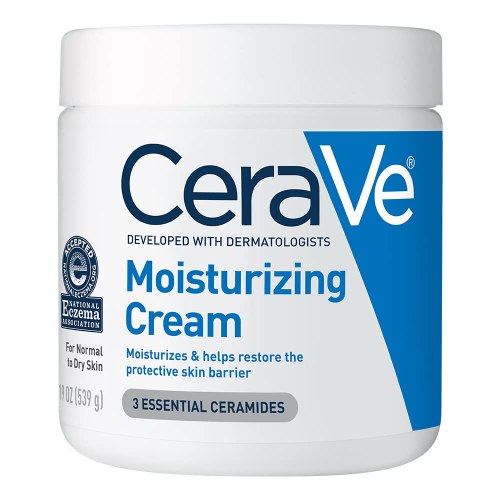
Best multipurpose: CeraVe Moisturizing Cream — $19.00
Key ingredients: Cermaides
“I love the CeraVe Moisturizing Cream for those with rosacea as it features ceramides and hyaluronic acid to hydrate, all while being affordable and free from added fragrance,” says Dr. Rubin. The hydrating cream is a favorite among those with sensitive skin, and the hyaluronic acid and essential ceramides inside are major keys to keeping sensitized, rosacea-prone skin hydrated and comfortable. What’s more, the pillow-soft cream can be used all over, on virtually any skin type—and who doesn’t love a multipurpose moisturizer?
Size: 19 oz.
Pros:
- Fragrance-free
- Fast-absorbing
- Seal of acceptance from National Eczema Assocation
Cons:
- May be too thick for some
Best for skin's microbiome

Best for microbiome support: Bliss Mighty Biome Ultra-Hydrating Moisturizer Concentrate, $25 — $25.00
Key ingredients: Beta glucan, postbiotics, beta carotene, ceramides, squalane
“Rosacea is a condition that makes skin ultra-sensitive to many ingredients, and [skin] can flare up if the products disrupt the natural barrier, or even if they disrupt the natural good bacteria found on skin,” says Dr. Nazarian. Which is why she loves Bliss Mighty Biome Ultra-Hydrating Moisturizer Concentrate. “[It] supports the healthy bacteria on our skin, avoiding disruption of the natural pH, and has many hydrating-boosting ingredients, like ceramides and squalane, to strengthen the skin barrier. All great for rosacea-prone skin.”
Size: 2 oz.
Pros:
- Cruelty-free
- Fragrance-free
- Ideal for all skin types
- Enriched with squalane and ceramides
Cons:
- May be too thick for some
Best oil-free
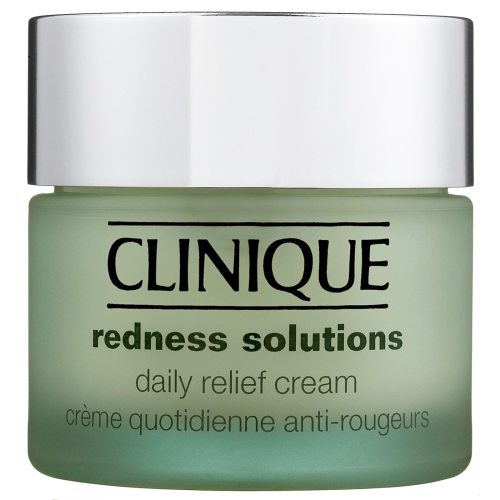
Best oil-free: Clinique Redness Solutions Daily Relief Cream — $63.00
Key ingredients: Probiotics (Lactobacillus)
Dr. Karp is a fan of this redness-reducing moisturizer for rosacea thanks to the fact that it includes probiotics, which help to balance the skin’s microbiome and keep inflammation—which, as you now well know, is the main culprit behind rosacea—at bay. The lightweight cream also happens to be oil-free, so you don’t have to worry about it clogging your pores and causing other types of acne in pursuit of clearing a rosacea flare. According to clinical trials conducted by the brand, 100 percent of participants saw a reduction in skin redness within 2.5 hours after applying the product, so if you’re looking for a quick fix (that will also help up your skin’s strength in the long run), this pick is worth investing in.
Size: 1.7 oz.
Pros:
- Reduces redness fast
- Oil-free, great for acne-prone skin
Cons:
- May not be hydrating enough for skin that skews dry
What is rosacea?
“Rosacea is considered a form of adult acne that is characterized by acne flare-ups, facial redness, flushing, and prominent facial blood vessels,” says Michele Green, MD, a cosmetic dermatologist based in New York City. The condition typically shows up when people are between the ages of 30 and 50 (FWIW, it can also appear during menopause as a result of hormonal fluctuations), and the American Academy of Dermatology estimates that it affects as many as 14 million Americans.
Though rosacea is technically a form of acne, the two are decidedly different, and thus require different forms of treatment. “Acne vulgaris”—the official name for your regular, run-of-the-mill breakouts—occurs when pores and hair follicles get clogged with dead skin cells, debris, and oil and become inflamed. Rosacea, on the other hand, is characterized by redness, papules, pustules, and swelling.”
“A common misconception with rosacea is that rosacea is a form of severe acne [vulgaris],” says Dr. Green. “It is important to note that acne [vulgaris] and rosacea are completely different skin conditions that require different treatments. Rosacea is typically a lifelong condition that occurs during middle age. Acne [vulgaris] is typically a temporary skin condition that begins during puberty.”
The difference between rosacea and redness
Because facial redness is a telltale sign of rosacea, and a regular occurrence for folks with sensitive skin, telling the two apart can be a challenge. According to Suzanne Friedler, MD, FAAD, a board-certified dermatologist and fellow of the American Academy of Dermatology, how long your redness lasts can be a key indicator. For example, if your skin gets flushed after running outside, but goes away after a few minutes—it’s probably just redness. “If you find that over time the redness starts to last longer and longer, and it doesn’t fully clear up, then that’s the beginning of rosacea,” says Dr. Friedler.
Another key difference between redness and rosacea is that rosacea is usually caused by a trigger. Kristina Collins, MD, FAAD, a double board-certified dermatologist and founder of Foy, says rosacea triggers can run the gamut from heat, light (yes, including sun exposure), and stress, to friction, alcohol, caffeine, and hot beverages. “Hormonal fluctuations can exacerbate flushing and redness,” adds Audrey Kunin, MD, a board-certified dermatologist and founder of DERMAdoctor. The key to getting a handle on your rosacea, according to Dr. Collins, is learning your triggers and proceeding with caution when it comes to skin care, sticking with products geared towards sensitive skin.
What triggers rosacea flare-ups?
The good news for anyone living with rosacea is that just because you *have* the condition, it doesn’t mean you’re stuck dealing with it all day every day—you just have to know what triggers to avoid in order to prevent a flare-up.
According to dermatologists, there are a number of different factors that can cause rosacea to flare.
1. Dietary factors
“Dietary factors include hot or spicy foods, caffeine, hot beverages, dairy products, spices and seasonings containing cayenne pepper or red pepper, and foods containing cinnamaldehyde, like citrus fruits, tomatoes, and chocolate,” says Dr. Green.
2. Lifestyle factors
“Lifestyle factors include stress, genetics, smoking, alcohol, exercise (i.e. hot yoga) and intense exercise, steam rooms, hot baths, hormonal or endocrine issues including thyroid diseases or menopause), hypertension, medications that dilate blood vessels including certain blood pressure medications, and certain skincare products like Retin-A creams or creams with fragrance or those that are alcohol-based,” says Dr. Green.
3. Environmental factors
Additionally, Dr. Green notes that the environment can also lend to rosacea flares. “Environmental factors include extreme heat or cold weather, wind exposure, and sun exposure,” she says.
However, it’s important to remember that not everyone’s flare-ups are triggered by the same thing. So, while chowing down on jalapeno poppers might make one person’s skin break out into an uncomfortable red rash, it may not have any effect at all on another’s. With that in mind, be sure to pay attention to your skin, and how it reacts to each potential factor.
How to calm a rosacea flare-up fast
When you’re dealing with the sort of red, uncomfortable rash that comes along with a rosacea flare, it’s understandable that you want to get rid of it as quickly as possible. According to Anna Karp, MD, a board-certified dermatologist in New York City, the first thing you should do is—literally—turn down the heat.
“The fastest way is cooling down the skin with a cold compress,” she says, adding that you should also avoid triggers like heat, spicy foods, and sun exposure. It’s also worth noting that there are certain foods that can actually help calm facial redness—like nuts, avocado, and cucumbers—so it may be worth loading your diet up with those any time you’re dealing with those.
If you don’t have a prescription cream from your dermatologist (who would typically prescribe something called Rhofade), Dr. Karp recommends an alternative DIY hack. “You can mix a bit of Afrin with a light moisturizer to instantly bring down redness by constricting the superficial blood vessels on the face,” she says, adding that the OTC decongestant has the same active ingredient as Rhodafade, called Oxymetazoline.
But! This trick only works if you’ve got the right moisturizer, so it’s important to know what to look for in one that won’t further irritate your flare-up.
Ingredients to look for in a moisturizer for rosacea
Dermatologists across the board recommend opting for ingredients with known anti-inflammatory benefits, and those that strengthen your skin’s protective moisture barrier. “Any ingredients that are calming and moisturizing are ideal for managing rosacea,” says Reid Maclellan, MD, the founder and CEO of Cortina, adjunct Faculty at Harvard Medical School and director of Proactive Dermatology Group. Erum Ilyas, MD, MBE, FAAD, a board-certified dermatologist at Schweiger Dermatology Group, echoes Dr. Maclellan’s sentiment. “Our focus when we choose moisturizers for rosacea are calming agents, anti-inflammatory agents, and antioxidants,” she says, including ingredients like niacinamide, squalane, and hyaluronic acid.
Another tip from Dr. Ilyas? Look for moisturizers that are marketed for sensitive skin. “Those products will be less likely to include ingredients that might be triggering inflammation,” she says.
Aloe vera
Everyone’s favorite natural skin-soother, aloe vera is a no-brainer for reducing the redness that comes with rosacea. “Aloe Vera can help temporarily alleviate redness and provide comfort during a flare-up,” says celebrity esthetician and owner of Sarah Akram Skincare, Sarah Akram. Aloe vera is also a natural humectant that helps bring moisture back to the skin, so it’s no wonder why dermatologists love it to help keep rosacea redness in check and give sensitive skin a dose of calming hydration.
Azelaic acid
“Azelaic acid in low concentrations is one of my go-tos for long term, non-irritating rosacea control,” Dr. Collins says. Dermatologist Geeta Yadav, MD, founder of FACET Dermatology in Toronto, Canada, also recommends azelaic acid, saying “it works by decreasing the inflammation and redness that is symptomatic of rosacea while helping combat bacteria on the surface of the skin.” The holy grail ingredient not only helps ward off acne and reduces the look of redness, irritation, and hyperpigmentation, it also gently exfoliates skin to prevent clogged pores and support a smooth, even-toned face.
Ceramides
“When shopping for rosacea-prone skin, it’s critical to look for a formula that includes ceramides,” says Dr. Yadav. “Ceramides are a natural part of your skin barrier that acts like the ‘mortar’ between the ‘bricks’ of your skin cells, helping to create a tight seal that prevents moisture from escaping while blocking out potential irritants.” Rosacea-prone skin or not, multiple derms told Well+Good that pretty much anyone can benefit from using a moisturizer with ceramides.
Hyaluronic acid
This particular ingredient is a fan-favorite for hydration, but is hyaluronic acid good for rosacea? The answer, according to dermatologists, is a resounding yes. “Hyaluronic acid acts as a humectant to lock moisture into the skin, leaving it hydrated,” says Dr. Maclellan. The ingredient delivers much-needed comfort to dry, rosacea-prone skin in the form of skin-plumping hydration, and when used correctly, hyaluronic acid also helps support a healthy skin barrier—which is a must for sensitive, rosacea-prone skin, according to derms.
Niacinamide
“Niacinamide is a form of vitamin B3 commonly used in skin-care products,” Joshua Zeichner, MD, board-certified dermatologist in New York City, previously told Well+Good. “It helps brighten the skin and lighten dark spots. It also helps calm inflammation and supports healthy collagen production.” In other words, niacinamide does everything rosacea-prone skin needs—it soothes, it brightens, and it improves your skin barrier.
Squalane
Squalane is another ingredient that comes with the recommendation of Dr. Yadav. Much like ceramides and hyaluronic acid, it supplies moisture to the skin, and it has the added benefit of hydrating without clogging the pores. “If you’re prone to dryness but are worried about breakouts, squalane should be on your radar,” she says, “as it mimics your skin’s natural oils without causing pore congestion.”
Keep in mind that everybody’s skin is different, and what works for one person may not work for others. A patch test could help you figure out how certain products or ingredients react with your skin, says. Dr. Ilyas. Test a product on your forearm before applying it to your face—“it can share the same sensitivities as the facial skin,” she says. The AAD recommends conducting a patch test for seven to 10 days, but you can also opt to see a trusted dermatologist to guide you through the process.
Sign up for the Well+Good SHOP Newsletter
Get exclusive deals on wellness, beauty, fitness, and food products that have been hand-picked by our editors.
Got it, you've been added to our email list.










